|
1.
CENTRAL AND WEST AFRICA
Regional sentiment
Across Gabon, Cameroon and Congo producers say
harvesting is moderate to low, constrained by weak export
demand. Repairs to roads and railways, critical for timber
transport, progress slowly. Power and fuel shortages
continue to challenge industrial operations, particularly in
Gabon’s veneer mills.
The sharp decline in Chinese demand remains the largest
factor affecting production, it is only purchases by
Vietnam and the Philippines that maintain the flow of
orders. In contrast, demand in the Middle East has shown
some slight improvement for certain hardwood species
such as Iroko, Sapelli and other redwoods. Overall,
mid‐February sees the timber sector still in a cautious
mode awaiting more robust international demand and
stability in power/infrastructure to fully resume
production.
Regional up-date
Gabon
Forestry officials in Gabon are moving forward with GPS
marking on sawnwood bundles but there is scepticism
about how effectively this can be enforced in practice. The
requirement to mark every bundle of sawn timber with
GPS data underscores the government’s emphasis on
traceability, even if the current level of on‐the‐ground
enforcement is uncertain. The push toward FSC
certification by the end of the year is adding extra pressure
on operators already dealing with weak demand.
Some veneer and plywood mills in the Nkok Special
Economic Zone are working at reduced capacity, often just
one shift, due to the slow overseas demand and power
disruptions.
Okoume peeler logs are reportedly trading around
70,000 FCFA/cu.m delivered. Good CS‐grade logs can sell
at up to 85,000 FCFA/cu.m. Sawlog prices in the local
market have increased to around 55,000 FCFA/cu.m (up
from 50,000 FCFA).
Ongoing repairs to key routes (such as Ndjole/Bifoun)
remain slow with only one lane open on some stretches.
Companies report that moving timber to Owendo Port can
take 2–3 days due to poor road conditions.
Cameroon
Logging operations have resumed but at reduced levels
due to slow international demand, particularly in China.
The dry season (now until June) should allow for easier
road maintenance but market sentiment remains cautious.
Trucking is reported “back to normal” as key routes have
been repaired, especially the road to Sangmelima, vital for
south‐Congo forest‐sawmill operators heading to the Kribi
Port.
It is reported that Douala Port currently sees fewer logs
arriving from North Congo and the Central African
Republic. Operations at the port are said to be better under
the port’s new management.
Republic of Congo
Production in the north is said to have returned to a
“normal” following the end of seasonal rains yet overall
output remains modest because of weak demand in Asian
and European markets. Chinese buyers have drastically
reduced orders pushing mills in the region to seek
alternative markets. Industries in the Congo suffer
frequent fuel shortages and reduced power supply in urban
areas is a challenge for businesses.
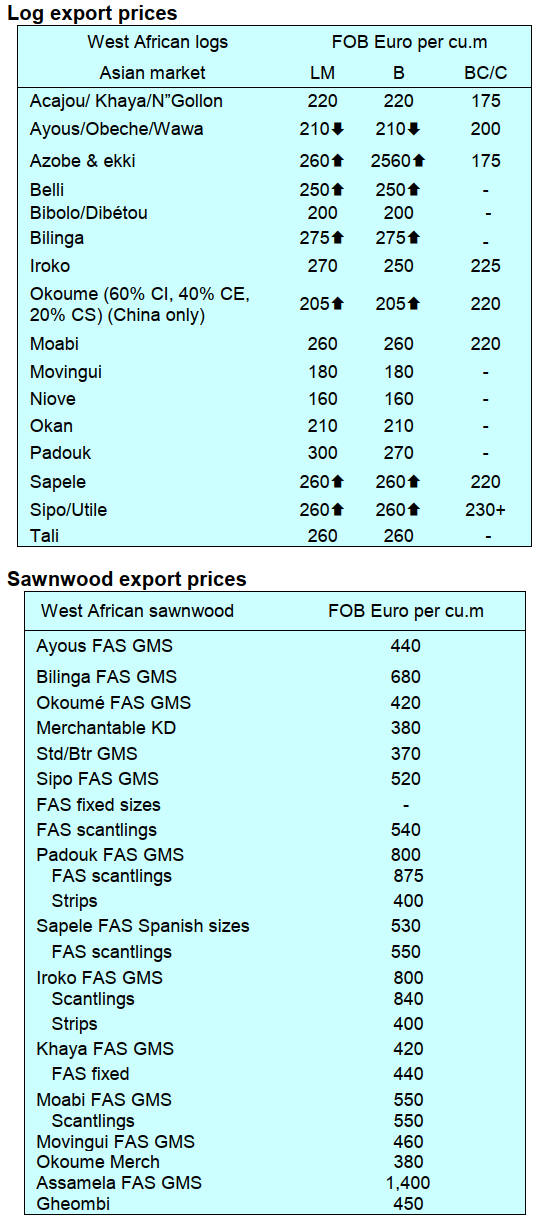
March trade mission to Cameroon
ATIBT will lead a trade mission to Cameroon. This
initiative has been arranged as part of the ASP-Green Pact
with the aim of promoting development of a sustainable,
climate resilient economic model in Cameroon. Support is
provided by the EU as part of the Cameroonian Forest
Governance Improvement Programme (PAMFOR).
ITTO has been advised that registration is still open.
See: https://www.atibt.org/en/news/13586/invitation-to-a-
professional-trip-to-cameroon-commit-to-a-green-economy-with-
the-asp-pacte-vert-project
2.
GHANA
New CEO for Forestry Commission
Stakeholders in the timber industry have applauded the
President appointment of Dr. Hugh C.A. Brown as the
new Chief Executive of Ghana’s Forestry Commission
(FC). Prior to his new appointment Dr. Brown, a
professional forester, served as the Executive Director of
the Forest Services Division of the Commission. The
industry acknowledged Dr. Brown's expertise and
experience in forestry management and anticipate he will
steer the timber industry and the Forestry Commission in
the right direction.
According to timber merchants from Ghana’s timber
producing areas in the Ashanti, Western, Western North
and Ahafo Regions, they are optimistic the new Chief
Executive’s leadership will not only boost the industry but
also contribute to the country's economic growth.
See: https://www.myjoyonline.com/timber-industry-hails-
president-mahamas-appointment-of-new-forestry-commission-
ceo/
and
https://www.peacefmonline.com/article/388379-timber-industry-
hails-president-mahamas-appointment-of-forestry-commission-
ceo
Ghana’s wood product exports decline again
Ghana earned Euro10.22 million from the export of
21,091 cu.m of wood products in December 2024, a
significant decline of nearly 7% in value and 8% in
volume compared to December 2023.
2024 exports earned US$123.47 million from a volume of
272,829 cu.m. of wood and wood products, a drop in
volume (7%) and in value (8%) when compared to same
period 2023.
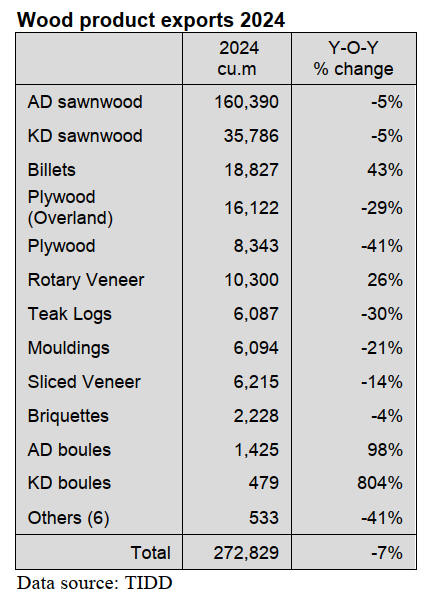
Air dried sawnwood accounted for 51% of the export
value in 2024 while figures for kiln dried sawnwood were
19%, sliced veneer 6%, billets, plywood (to the regional
market) and mouldings 5% and rotary veneer 4%. These
altogether accounted for 95% (Eur 116.79 million) of total
revenue earned from timber exports.
The major markets for timber from Ghana were India,
Egypt, Vietnam, United States of America, Belgium,
Germany, Senegal, Italy, Burkina Faso and Togo. Others
included United Kingdom, Saudi Arabia and Estonia.
Wawa, ofram, makore, edinam, sapele, denya, ceiba, teak
and gmelina featured prominently in the export of
sawnwood, rotary veneer, sliced veneers billet and
plywood.
Analysis of the 3-year data for 2022, 2023 and 2024
showed a declining export trend in both volumes and
values. One of the main reasons cited for the downtrend
was inadequate raw material.
Air-dried sawnwood accounted for close to 60% of the
total export volume in each of the three years reported and
together with kiln dried accounted for over 70% while
about sixteen other products accounted for the remaining
30% of the total export volume.
Chiefs and traditional authorities involved in fighting
illegal mining
The Minister of Lands and Natural Resources, Emmanuel
Armah-Kofi Buah, has announced his Ministry’s key
objectives among which he has the vision of the roll-out of
a multi-pronged measure to deal with illegal mining
(galamsey) activities in the country.
Speaking at his first meeting with staff and management of
the Ministry in Accra, the Minister enumerated fresh
measures that would aid in his programme to halt illegal
mining activities, restore forest reserves and create a
mining sector that will not damage water bodies.
The Minister did not rule out the strengthening
intelligence-led swoops that had been deployed over the
years to tackle the problem. He added that there would
also be comprehensive and coordinated interventions
involving Chiefs, Metropolitan, Municipal and District
Assemblies (MMDAs), security agencies, civil society
organisations and others to help deal with the root cause of
illegal practices.
According to the Minister, the government’s focus is to
reform the forestry, mining and land sectors and make sure
that Ghanaians have a pathway to legal mining. He tasked
the Forestry Commission to focus on protecting the forest
reserves and to heal degraded forest resources. He
promised reforms at the Lands Commission to make their
services accessible to the people.
He implored on Chiefs and traditional authourities to lead
the fight against galamsey as they will actively be engaged
in the pre- and post-licensing mining periods to keep them
abreast of activities in their jurisdictions.
Meanwhile the Lands Minister, has inaugurated an 18-
member committee to develop a blueprint within two
weeks for the reform of the mining sub-sector.
New Bank of Ghana Governor
The President has nominated Dr. Johnson Asiamah as the
new Governor of the Bank of Ghana (BoG), following the
impending retirement of the current Governor, Dr. Ernest
Addison, who formally requested to proceed on leave
ahead of his retirement. Dr. Asiamah is an economist and
former Deputy Governor of the BoG (2016-2017) with
over 23 years of experience in monetary policy
formulation, financial stability regulation and economic
management.
The First and Second Deputy Governors of the BoG Dr.
Maxwell Opoku-Afar and Mrs. Elsie Addo Awadzi have
also decided to leave ahead of the expiration of their
tenure.
Meanwhile, an International Monetary Fund (IMF) team is
already in the country to hold a series of engagements with
government about the economy. The discussions will
focus on the economy and the 2025 Budget. Ghana has
received about US$1.9 billion to support the economy
since 2023.
See: https://thebftonline.com/2025/01/31/dr-johnson-asiamah-
nominated-as-bog-governor/
and
https://www.myjoyonline.com/imf-begins-talks-with-
government-on-economy-2025-budget-from-today/
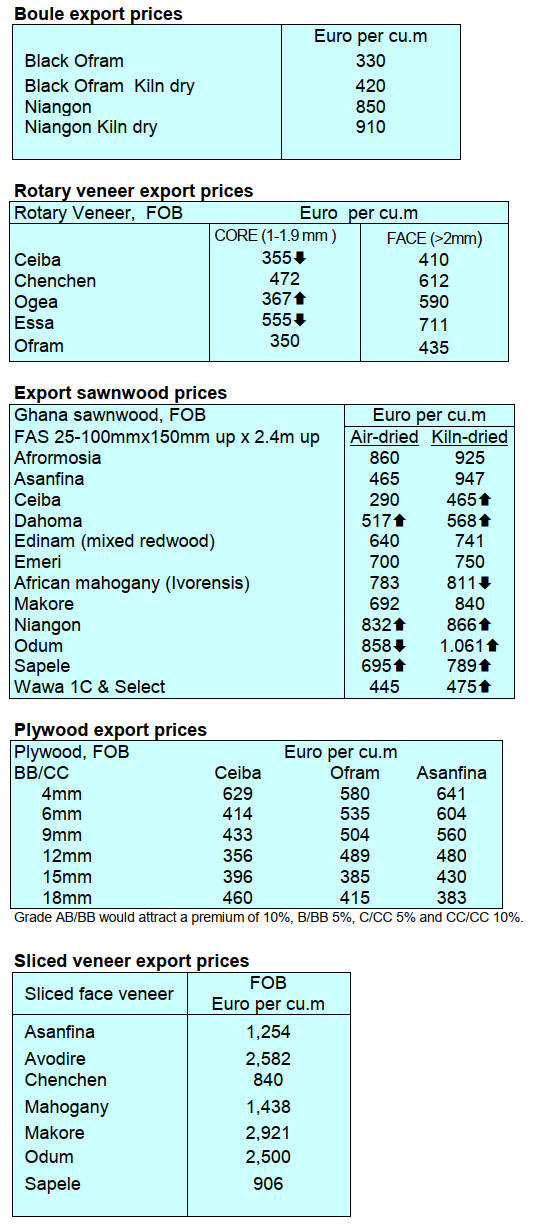
3. MALAYSIA
Expanding wood products certification scheme
The Sarawak Timber Association (STA), in its latest
STAReview, reports on the Malaysian Timber Industry
Board (MTIB) engaging the Institute of Tropical Forestry
and Forest Product of Universiti Putra Malaysia to
recommend improved data generation to expand MTIB’s
Wood Product Certification Scheme.
This is part of the Government's efforts to explore
opportunities to expand the certification scheme to include
products that meet the demand in the global market.
In this connection, a roundtable session with stakeholders
was held to exchange ideas and discuss issues related to
requirements, impacts, challenges, opportunities and
relevance of certification in advancing the country's
Sustainable Development Goals.
Discussions included offering incentives to companies that
demonstrate strong commitment to improving product
quality, implementing cost-sharing measures to ease the
financial burden on businesses, ensuring government
recognition of certified products, enhancing market access
for certified product and strengthening collaboration and
synergy among various Government agencies.
See: https://sta.org.my/images/STAReviewDec2024.pdf
The STAReview also reported that the Malaysian Timber
Certification Council (MTCC) organised an inception
workshop for the ‘Promoting Sustainable Wood Use for
the Domestic Market in Malaysia’. The workshop was
attended by policymakers, research institutions, timber
associations and industry players to discuss and provide
inputs on the project inception report.
In his opening remarks, Akmal Saarani, Director (Chain of
Custody) at MTCC announced that this project, funded by
the International Tropical Timber Organization, is an
initiative aimed at enhancing and diversifying domestic
consumption while promoting local markets for
sustainable wood and wood products in Malaysia.
With MTCC appointed by the Ministry of Plantation and
Commodities as the executing agency, this 18-month
project has the ambitious goal of increasing domestic
consumption, improving supply chains and reinforcing
government policies related to the use of sustainable wood
products.
See: https://sta.org.my/images/STAReviewDec2024.pdf
and
https://www.instagram.com/p/DDv0h4OTdwD/?img_index=1
Sabah Timber Industries Association supports
plantation plan
Sabah Timber Industries Association (STIA) reaffirmed its
commitment to support the State Government’s forest
plantation target of planting 400,000 hectares as outlined
in the Forest Plantation Development Action Plan. Its
President, Tan Peng Juan, said this initiative aims to
reduce reliance on natural forest species.
The Forest Plantation Development Action Plan (2022–
2036) is a strategic initiative by the Sabah Forestry
Department aimed at transforming forest plantation
development in Sabah. It was launched in March 2022.
The 15-year plan provides guidance in accordance with
sustainable forest management principles as outlined in the
Sabah Maju Jaya Development Plan (2021–2025) and the
Sabah Forest Policy.
The Sabah timber industry recorded a steady increase in
exports from January to November 2024, with an average
rise of 11% in volume and 6% in value compared to the
same period in 2023.
Japan remained the largest importer accounting for 22% of
the total export value followed by the United States (11%)
and Taiwan P.o.C (9%). Exports to European countries
were negligible contributing only around 2% to total
earnings.
See: https://www.dailyexpress.com.my/news/251404/undefined/
and
https://www.dailyexpress.com.my/news/251406/undefined/
Malaysian International Furniture Fair
The Malaysian International Furniture Fair (MIFF) will
take place on 1-4 March 2025 in the World Trade Centre
Kuala Lumpur (WTCKL) and Malaysia International
Trade & Exhibition Centre (MITEC) in Kuala Lumpur.
The organisers say over 650 furniture manufacturers and
exporters will be exhibiting from Australia, Cambodia,
China, India, Indonesia, Hong Kong, Japan, South Korea,
Taiwan, Thailand, Vietnam, UAE and USA.
See: https://miff.com.my/register-
now/?cid=edm230125NewExh
4.
INDONESIA
Export Benchmark Price (HPE) of Wood for
February
2025
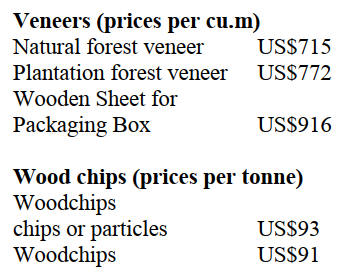
Processed wood (prices per cu.m)
Processed wood products which are leveled on all four
sides so that the surface becomes even and smooth with
the provisions of a cross-sectional area of 1,000 sq.mm to
4,000 sq.mm (ex 4407.11.00 to ex 4407.99.90)
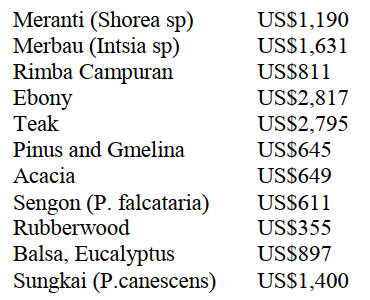
Processed wood products which are leveled on all four
sides so that the surface becomes even and smooth of
Merbau wood with the provisions of a cross-sectional area
of 4000 mm2 to 10000 mm2 (ex 4407.11.00 to ex
4407.99.90) = 1,500 US Dollars/cu.m
See: https://jdih.kemendag.go.id/peraturan/keputusan-menteri-
perdagangan-republik-indonesia-nomor-122-tahun-2025-tentang-
harga-patokan-ekspor-dan-harga-referensi-atas-produk-
pertanian-dan-kehutanan-yang-dikenakan-bea-keluar
Forestry targets 400,000 job creation
The Minister of Forestry, Raja Juli Antoni, said the
government is targeting an investment of IDR19.9 trillion
in the forestry sector which is expected to create 400,000
jobs. This was reported during a meeting with
Commission IV of the Indonesian House of
Representatives. The Minister stated that the theme for the
Ministry of Forestry's development in 2025 is to enhance
forest production and promote downstream activities to
ensure equitable economic development across regions.
The forestry development theme for 2025 aims to achieve
several objectives. The first is to enhance economic
growth by increasing the contribution to GDP and increase
exports by 3-5%t; second, equitable regional development
through increasing the capacity of forest farming groups
by 7-8% and third;, reducing deforestation by 3-4%.
See: https://www.antaranews.com/berita/4605338/menhut-bidik-
investasi-kehutanan-rp1919-triliun-dan-400-ribu-pekerja
18 Companies lose their concession rights
The Minister of Forestry announced the government has
revoked forest management licenses for 18 companies that
collectively controlled 526,144 hectares of land. The
decision was made after it was observed these companies
failed to manage the forests sustainably for the economic
benefit of surrounding communities.
See: https://jakartaglobe.id/business/govt-revokes-concessions-
of-18-companies-controlling-over-half-a-million-hectares-of-
forest-land
and
https://news.detik.com/berita/d-7761324/menhut-cabut-izin-
pemanfaatan-hutan-18-perusahaan
Furniture and craft industry urged - be aware global
challenges
Indonesia's furniture and craft industry is facing significant
challenges due to the global situation, particularly the high
tariff policies by the USA said Fajarini Puntodewi,
Director General of National Export Development at the
Ministry of Trade. He warned that Indonesian products
may struggle to enter the US market adding "our primary
export destinations are the United States, which holds a
market share of 53% and the European Union, accounting
for over 15%.
Within the EU, significant markets include the
Netherlands, Germany, Belgium, France and Spain, we
also export to Asian countries such as Japan, said Fajarini.
The domestic industry must improve as global demand for
furniture and crafts remains promising. The positive
growth trend is projected at 15%. Specifically for furniture
products the global market size reached US$770 billion in
2024 and is expected to reach US$925.46 billion by 2029.
See: https://www.cnbcindonesia.com/news/20250207192419-4-
609001/kemendag-tiba-tiba-minta-industri-mebel-kerajinan-ri-
waspada-ada-apa
New regulation on depositing export earnings a
challenge says association
The Indonesian Furniture and Craft Industry Association
(Himki) stated that the mandatory policy requiring the
depositing of 100% of foreign exchange proceeds from
export within one year could negatively impact the
national furniture and craft industry which is export-
oriented, labour-intensive and closely integrated with the
global supply chain.
Export proceeds are essential for business capital,
including for the purchase of high-tech production
machines which also require access to foreign exchange
because they have to be imported.
Business stakeholders are currently concerned about the
requirement to deposit export earnings in domestic
accounts as this could restrict their access to foreign
currency. Additionally, fluctuations in exchange rates
could negatively impact exporters when converting
currencies.
There are also risks to cash flow and the long-term
sustainability of the business according to the Association
as company's liquidity could be affected, particularly for
small SME exporters who rely heavily on the flexibility of
deposits for their operational and expansion needs.
The Association has requested the government carefully
consider this policy to ensure it does not impede exporters
in the creative industry sector who require significant
support from the government. He hopes a scheme will be
established allowing companies to withdraw foreign
currency in specific amounts without time limits provided
it is used for productive purposes.
See:https://www.msn.com/id-id/berita/other/industri-mebel-
waswas-kebijakan-wajib-parkir-dhe-1-tahun-bikin-modal-
seret/ar-AA1yshsV?ocid=BingNewsVerp
Promotion in the Middle East and Africa, APHI Visits
ITPC Dubai
Secretary General of the Indonesian Forestry
Entrepreneurs Association (APHI), Purwadi Soeprihanto,
visited the Indonesia Trade Promotion Center (ITPC)
Dubai, United Arab Emirates to strengthen the promotion
of wood products to the Middle East and African markets.
In a statement he said “Dubai is a potential hub for the
Middle East and Africa markets."
Importers met represented two market categories in Dubai,
namely the niche market for high-end hotels, apartments
and residences represented by Fakih Group and Tarrab
Group and the retail market represented by Rahmani
Group.
See: https://forestinsights.id/promosi-produk-kayu-di-timur-
tengah-dan-afrika-aphi-kunjungi-itpc-dubai/#
Agroforestry to achieve food self-sufficiency
The Indonesian government has opted to promote and
adopt the agroforestry approach to cultivate gogo-type
(dry) paddy on 1.1 million hectares across the country to
achieve self-sufficiency in food. Speaking in Indramayu,
West Java, Forestry Minister, Raja Juli Antoni, stated that
his Ministry is collaborating with the Ministry of
Agriculture to execute this initiative.
The Minister then stated that his Ministry also identified
an additional 1.4 million hectares of land suitable for corn
cultivation. Meanwhile, Agriculture Minister, Andi Amran
Sulaiman, commended the Forestry Ministry for endorsing
agroforestry to ramp up food production.He emphasised
that synergy between the forestry and agriculture sectors is
key for Indonesia to solidify its food security.
See: https://forestinsights.id/dukung-ketahanan-pangan-
kemenhut-kementan-garap-agroforestry-perhutanan-sosial/#
Indonesia introduced multi-business Sustainable
Forest Management
At the ‘Forest Governance, Markets and Climate (FGMC)
Stakeholder Forum 2025’ in London, Indonesia unveiled
its Multi-Business Forestry Scheme to promote sustainable
forest management. Agus Justianto explained that in
Indonesia traditional forest management faces the
challenges of deforestation, loss of biodiversity and
tenurial conflicts and that a transformation of forest
management policies is needed.
Agus explained the transformation of forest management
in Indonesia involves first reorienting forest management
with a sustainable forest management approach and
community involvement. Indonesia, said Agus, is
currently transforming its forest management policy by
implementing Multi-Business Forestry (MUK) which is
oriented towards forest landscape management.
By implementing MUK, forestry concessions can carry
out various business activities in the form of utilising
wood and non-wood forest products, environmental
service and utilising areas to optimise the potential of
forest products," said Agus. Through MUK, community
involvement in forest management will also be more open.
This is because forestry concessions (Forest Utilization
Business Permits/PBPH) can implement agroforestry to
develop non-forestry commodities while still paying
attention to forest sustainability.
See: https://forestinsights.id/di-fgmc-stakeholder-forum-
indonesia-ekspos-skema-multi-usaha-kehutanan-untuk-
pengelolaan-hutan-lestari/#
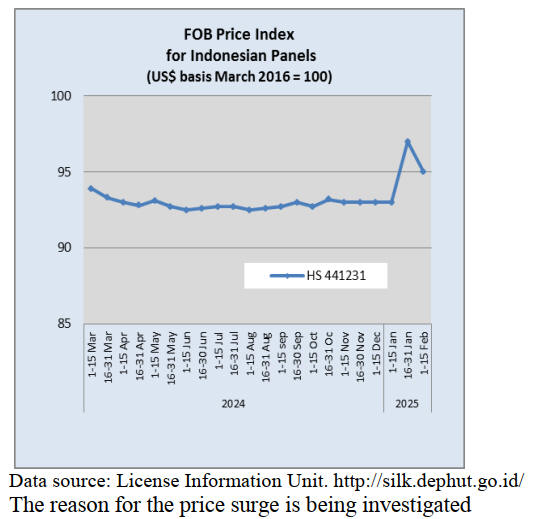
5.
MYANMAR
Export sawnwood specification amended
In August 2022, when the classification of primary wood-
based products was announced, the sectional area of sawn
timber with a size of 24 square inches and a maximum
width of 4 inches was classified as semi-finished and
eligible for export. Recently, the specification for the
sectional area was increased to 36 square inches.
However, it is understood that timber exceeding 24 square
inches is subject to a Special Goods Tax of 5%. Since
Myanmar's wood-processing sector is predominantly
based on primary processing, increasing the limit may
result in higher production yields.
Wood based industries
In 2015-16, there were approximately 333 wood-based
industries in Myanmar, 12 of which were foreign ventures.
Following the sanctions imposed on Myanmar Timber
Enterprise (MTE) after 2021 and the resulting near
collapse of exports to major markets, it is now believed
that fewer than ten export-oriented factories remain.
In addition, Myanmar's state owned woodbased industries
were under the control of Myanmar Timber Enterprise.
Until 2014, MTE operated 65 sawmills and 18 woodbased
industries, and it reserved certain logs for use in these
mills.
In 2014-15 MTE began selling more logs to the private
sectorwith the exception of small quantities reserved for
few sawmills that were required to produce for state
projects and needs. Most MTE sawmills and woodbased
industries are now leased to the private sector.
Trade surplus forecast
Myanmar estimates that there will be a trade surplus in the
2024-2025 fiscal year as a result of the prospect of exports
surpassing import, according to 2024-2025 Fiscal Year’s
Financial Policy Paper released by the Budget Department
under the Ministry of Planning and Finance.
The paper stated that the export value is anticipated at
US$16.7 billion, the import value is US$16.3 billion, and
the trade surplus is US$400 million. The Minister of
Commerce and Industry, Htun Ohn, said that 60% of the
export target had been achieved between April and
November in the 2024-2025 fiscal year.
Myanmar mainly exports rice, pulses, seafood and
clothing while importing capital goods, industrial raw
materials and consumer good. In the last fiscal year the
country earned about US$14.614 billion from exports.
The export drive will face a major hurdle as many young
workers have left the country to avoid conscription into
the armed forces and this is severely impacting
Myanmar’s garment industry. Garment factories are
reporting a 20% drop in production as recruiting new
workers and finding skilled labor becomes increasingly
difficult.
See- https://eng.mizzima.com/2024/12/22/17572
and
See- https://www.irrawaddy.com/business/economy/myanmars-
garment-industry-unravelling-amid-chronic-labor-shortage.html
Emergency rule extended
The State Administration Council has extended the four-
year emergency rule delaying plans for long-promised
general elections. The National Defence and Security
Council extended a state of emergency for another six
months until 31 July according to a government statement
The emergency rule has now been extended for six times.
The regional media has reported China is playing a key
role in brokering peace talks between the administration
and ethnic armed groups the latest being a ceasefire
agreement with the Myanmar National Democratic
Alliance Army.
See-
https://www.businesstimes.com.sg/international/asean/myanmar
-generals-extend-emergency-rule-again-delaying-polls
In related news, the Jakarta Post published a long article
saying ASEAN must move beyond empty diplomacy and
hold Myanmar’s military accountable.
See- https://www.thejakartapost.com/opinion/2025/02/12/time-
to-end-aseans-accommodative-approach-in-myanmar.html
Formation of development commissions amid
deepening economic crisis
The administration has announced three new development
commissions as the country grapples with severe
infrastructure and economic challenges. The Electricity
and Energy Development Commission, chaired by Deputy
Prime Minister General Tin Aung San, aims to address the
nation’s critical power shortages.
The power crisis has triggered factory closures across
industrial zones prompting the formation of the Industrial
Development Commission. This commission is led by
Deputy Prime Minister and Union Minister for Transport
and Communications, General Mya Tun Oo.
Additionally, the administration established the
Agriculture and Livestock Development Commission
chaired by General Nyo Saw, a member of the military
council. These commissions emerge as Myanmar’s
economy faces significant challenges.
See- https://eng.mizzima.com/2024/12/21/17551
6.
INDIA
Sawnwood price continues
to climb
The annual rate of inflation based on the India Wholesale
Price Index (WPI) was 2.37% in December 2024. The
positive rate of inflation in December 2024 was primarily
due to increase in prices of food articles, manufactured
food products, other manufacturing, manufacture of
textiles and non-food articles.
The index for the manufacturing sector in December 2024
was the same as that in November. Out of the 22 groups
for manufactured products 11 saw an increase in prices, 9
a decrease and 2 groups, including wood panels, saw no
change in prices.
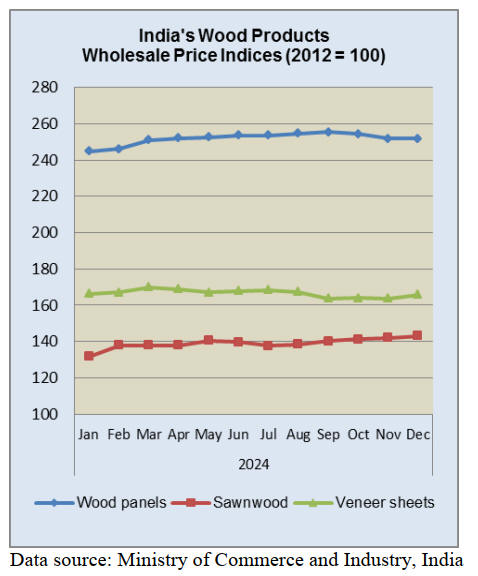
Some of the important groups that showed month on
month price increases were sawnwood, wood veneers,
textiles, fabricated metal products except machinery &
equipment), other non-metallic mineral products, motor
vehicles, chemicals and chemical products.
Some of the groups that saw declining prices were basic
metals, food products and furniture.
See: https://eaindustry.nic.in/pdf_files/cmonthly.pdf
Tax cuts to drive consumption
In announcing the annual budget Finance Minister,
Nirmala Sitharaman, indicated the government will cut
personal income tax rates to spur middle-class spending
and accelerate growth. India's economy is projected to
expand by 6.4% in the current financial year, the weakest
pace in four years currently, consumers facing with high
food price inflation.
Interest rate cut, first in five years
The private sector has welcomed the Reserve Bank of
India’s decision to lower interest rate for the first time in
nearly five years saying this will complement the
consumption-boosting measures announced in the budget
to support fading growth in the hope that inflation will
ease to 4.4% in the first quarter and be a steady 4.2%
through 2025-26.
https://www.thehindu.com/business/Economy/rbi-
monetary-policy-committee-meeting-
friday/article69190903.ece#cxrecs_s
Panel prices to be raised
The Kandla Timber Association (KTA) has announced
that due to rising raw material costs, inflation and rising
log prices producers have been compelled to increase
plywood prices by 5 % and flush door and blockboard
prices have been raised by Rs3/sq. ft.
The decision to increase the prices was taken jointly by
members of the Kandla Timber Association (KTA) and
members of Haryana Plywood Manufacturers Association
(HPMA). Both are leading associations in the Indian wood
panel industry and say that due to significant increases in
the cost of raw materials, including timber, resin and rising
labour cost the decision has been made by all the members
to implement a price increase on plywood products.
The rise in timber prices, combined with escalating resin
and labour costs, has made this change necessary to
maintain the quality and consistent supply of the product.
The Associations say “while we understand that price
increases can be challenging this decision has been made
collectively to ensure the continued sustainability of the
industry.
In related news, members of the All India Plywood
Manufacturers Association (AIPMA) has decided to
increase the rate of Shuttering Plywood (12mm) by
Rs3/sq. ft. the price of other thicknesses will be increased
prorata.
The decision to increase prices was unanimously taken
after rigorous discussions among plywood manufacturers.
It was been noted that increased raw material prices and
the high moisture content of logs aggravate the situation.
Both decisions are applicable with immediate effect and
no order will be accepted by any member at old rates. It is
very likely that prices will be reviewed again at the next
meeting following the continued increase in the log prices.
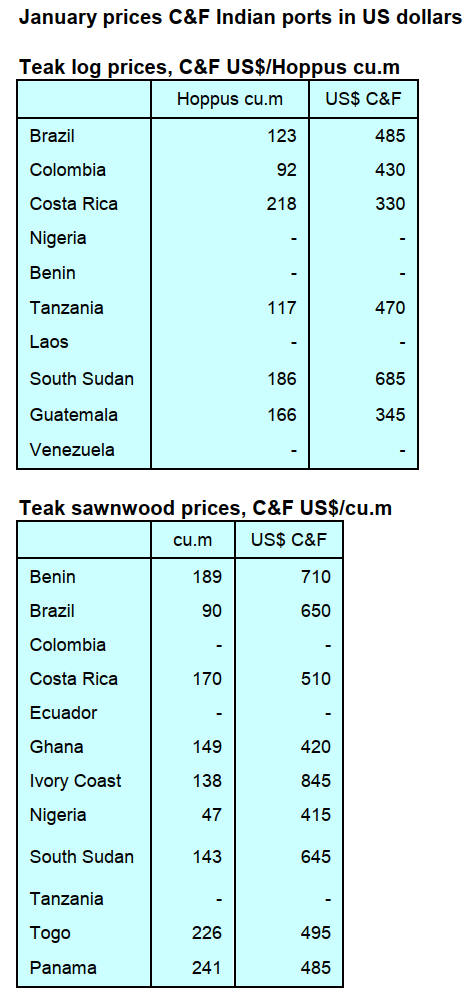

7.
VIETNAM
Wood and wood product (W&WP)
trade highlights
title
Vietnam’s W&WP exports to the US in December 2024
reached US$887.4 million, up 7% compared to November
2024 and up 19% compared to December 2023.
Vietnam’s imports of raw wood (logs and sawnwood) in
December 2024 amounted to 506,900 cu.m, worth
US$162.7 million, up 8% in volume and 8% in value
compared to November 2024. Compared to December
2023 imports increased by 37% in volume and 34% in
value. In 2024 imports weret 5.59 million cu.m, worth
US$1.81 billion, up 26% in volume and 20% in value
compared to 2023.
Vietnam's pine imports in December 2024 totalled 70,100
cu.m, worth US$15.0 million, down 17% in volume and
21% in value compared to November 2024. Compared to
December 2023 imports increased by 53% in volume and
43% in value. In 2024 imports of pine totalled 975,600
cu.m, worth US$218.2 million, up 38% in volume and
41% in value compared to 2023.
Vietnam’s NTFP exports in December 2024 increased for
the second consecutive month reaching US$80.29 million,
up 19% compared to November 2024 and up 13% over the
same period in 2023. In 2024 NTFP exports were valued
at US$803.08 million, up 10% compared to 2023.
Spectacular export performance in 2024
The wood products industry experienced a spectacular
export performance in 2024 following a sharp 16% decline
during 2023 said Ngo Sy Hoai, Vice Chairman and
Secretary General of the Viet Nam Timber and Forest
Product Association (VIFOREST).
Despite the success challenges are ahead as both the EU
and US markets increasingly demand stricter traceability
of wood origin. Alongside enforcing green growth and
digital transformation criteria Ngo said that VIFOREST
will prioritise enhancing trade defense capabilities for
businesses in an effort to drive the industry forward.
VIFOREST will work with the Trade Remedies Authority
and Vietnamese trade offices overseas to issue timely
warnings and help businesses avoid trade defense cases.
Tran Quang Bao, Director General of the Department of
Forestry under the Ministry of Agriculture and Rural
Development, will promote Vietnam’s Timber Legality
Assurance System (VNTLAS), strengthen links across the
supply chain from forest growers to processing and export
enterprises and support businesses in engaging in
international trade fairs to secure contracts and promote
Vietnamese wood products.
In addition to building high-tech processing zones,
expanding export market share, proactively promoting
trade in wood and wood products in major markets,
developing sales through e-commerce channels.
The wood industry needs to pay more attention and invest
in raw material sources. Specifically, it is necessary to
develop more large timber plantations, sustainably
managed forests and certified forests.
See: https://en.baochinhphu.vn/wood-industry-eyes-us18-billion-
export-turnover-in-2025-11125011315534835.htm
Wood production and sustainable forest management
Wood production in Vietnam in 2024 was estimated to
have reached 23.3 million cubic metres, up from 20.8
million cubic metres in 2023. This growth reflects the
country’s continuous investment in forestry and expanding
plantation areas.
A significant portion of the timber harvested in Vietnam
comes from plantation forests, which account for over
80% of the total output. The shift towards plantation
forestry has been a deliberate strategy aimed at reducing
pressure on natural forests while meeting the rising
demand for raw materials. The government’s afforestation
programmes and incentives for private sector participation
have contributed to this outcome.
One of the most prominent trends in Vietnam’s wood
industry is the focus on sustainable forest management and
the use of certified wood. As global consumers
increasingly demand environmentally responsible
products, Vietnamese manufacturers are adopting
international standards such as the Forest Stewardship
Council (FSC) certification. By 2024, over 1 million
hectares of forests in Vietnam will be FSC-certified,
reflecting the country’s commitment to sustainable
practices.
Another trend is the rising adoption of technology in wood
processing and manufacturing. Many companies are
investing in advanced machinery and automation to
improve efficiency, reduce waste and meet the stringent
quality requirements in export markets. Additionally, the
shift towards high-value-added products, such as custom-
designed furniture, has gained momentum as
manufacturers seek to enhance their competitiveness.
Wooden furniture continues to dominate Vietnam’s wood
product exports, accounting for over 60% of total exports.
This growth has been driven by high demand in key
markets such as the United States, China, Japan, and South
Korea. The United States remains the largest market,
driven by high demand for furniture and home goods.
China plays a key role as both a market and a processing
hub for Vietnamese wood products. Japan and South
Korea continue to grow as significant markets. Demand in
European Union has expanded driven by the EU-Vietnam
Free Trade Agreement (EVFTA), which has reduced
tariffs on Vietnamese wood products.
Challenges and prospects for the wood industries
Despite its impressive growth Vietnam’s wood industry
faces several challenges. One major issue is the increasing
scrutiny of the legality of timber sources.
With stringent international regulations, such as the EU’s
Deforestation Regulation, Vietnamese exporters must
ensure that their products comply with these requirements.
Non-compliance could lead to trade restrictions and loss of
market access.
Another challenge is the rising cost of raw materials and
labour. As Vietnam’s economy grows wages have been
increasing putting pressure on profit margins. Moreover,
the reliance on imported wood materials exposes the
industry to fluctuations in global supply and prices.
Climate change is also a looming threat with unpredictable
weather patterns affecting timber yields and quality.
Addressing these issues requires investments in climate-
resilient forestry practices and technologies.
Looking ahead, the prospects for Vietnam’s wood industry
remain positive. The global demand for wooden furniture
and sustainable products is expected to grow, offering
ample opportunities for Vietnamese manufacturers.
Government support in the form of favorable policies,
trade agreements and financial incentives will further
bolster the sector.
Moreover, the increasing urbanisation and middle-class
growth in Asia, particularly in China and India, present
untapped markets for Vietnamese wood products. By
diversifying their market base and focusing on innovation,
Vietnamese companies can reduce reliance on traditional
markets and ensure long-term sustainability.
In 2025 Vietnam’s wood products market will continue to
thrive, driven by steady timber output, robust export
performance and adoption of sustainable practices. While
challenges such as regulatory compliance and rising costs
persist the industry’s resilience and adaptability offers a
promising outlook. By embracing innovation and
sustainability, Vietnam is well-positioned to maintain its
status as a global leader in the wood products industry.
See: https://b-company.jp/vietnam-wood-industry-in-2024-and-
prospects-for-sustainable-development/
Fund for forestry development programme
The Ministry of Finance is currently seeking public
feedback on a draft Circular amending and supplementing
certain articles of Circular No. 21 which regulates the
management and use of operational funds for the
implementation of the sustainable Forestry Development
Programme.
The draft adds regulations on funding for activities related
to forest protection, forest development, improving forest
productivity and quality and sustainable forest
management (added as Article 3a) as follows:
Funding will be for activities that protect special-use
forests, support livelihood development, improve the lives
of people in buffer zones of special-use forests, protect
forests and support the protection of natural production
forests during forest closures.
It also covers activities such as promoting natural
regeneration, supporting the development of sustainable
forest management plans, obtaining sustainable forest
management certification and supporting scattered tree
planting and contracted forest protection.
The content and level of funding will follow Decree No.
58/2024/NĐ-CP dated May 24, 2024, on certain
investment policies in forestry and the guidance from the
Ministry of Agriculture and Rural Development (MARD)
outlined in the Circular regulating certain forestry
activities under the Sustainable Forestry Development
Program and the National Target Program for Socio-
Economic Development in Ethnic Minority and
Mountainous Areas for 2021-2030.
See: https://vietnamagriculture.nongnghiep.vn/new-proposal-on-
fund-using-for-sustainable-forestry-development-program-
d402295.html
8. BRAZIL
Periodic halt to native timber harvesting
The ban on harvesting in the natural forests in Mato
Grosso State runs from 1 February to 1 April during the
rainy period to protect the soil when it is more susceptible
to degradation due to the use of heavy machinery.
This restriction was established by Resolution No.
406/2009 of CONAMA (National Environmental Council)
and regulated in the state by Resolution No. 10/2017 of
SEMA-MT (State Environmental Secretariat of Mato
Grosso) which mandates that competent environmental
authorities define the periods of restricted logging,
skidding and log transportation.
However, the transportation of logs from log yards is
allowed, provided that the logs were registered in the
System for Forest Products Trade and Transport (Sisflora)
before the prohibition period.
Currently, approximately 6% of Mato Grosso’s territory is
under Sustainable Forest Management Plans (SFMP ) with
a target of reaching 6 million hectares by 2030.
The adoption of SFMP helps promote sustainable forest
use, environmental conservation and socioeconomic
development and prevents degradation and deforestation.
See: https://forestnews.com.br/comeca-periodo-proibitivo-da-
colheita-de-madeira-nativa-em-mato-grosso/
Pará advances with concessions for forest restoration
The State of Pará in the Amazon region is developing a
State Concession Programme for Forest Restoration as
part of the Native Vegetation Recovery Plan (PRVN).
During a recent meeting at the Secretariat of Environment
and Sustainability (SEMAS) a map of new areas that may
be granted to the private sector was presented along with
the integration of this initiative into other public policies
and the definition of additional technical aspects of the
project.
The foundation of the programme is based on the
concession notice issued during COP 29 of the UNFCCC
last year which aims to restore over 10,000 hectares
located in the Triunfo do Xingu Environmental Protection
Area (APA) in Altamira municipality, known as the
Triunfo do Xingu Restoration Unit (URTX).
According to SEMAS one of the main goals is to
designate over 100,000 hectares of public land to the
Restoration Unit Concession Programme by 2026.
One of the key features of the URTX project is the
Integrated Action Plan which seeks to improve the quality
of life for local communities through investments in
security, education, logistics, healthcare, infrastructure,
public services and environmental and land regularisation.
See: https://forestnews.com.br/para-prepara-programa-de-
concessoes-para-restauracao-florestal/
Cooperation on environmental governance in the
Amazon
The Ministry of Foreign Affairs (MRE) has published a
technical cooperation agreement with Germany for the
implementation of the ‘Technical Cooperation Project on
Land Governance and Environmental Control in the
Amazon’. It is reported the German government will
invest EUR2.5 million to the project with execution led by
the Ministry of Agrarian Development and Family
Agriculture (MDA). The Brazilian Cooperation Agency of
the Ministry of Foreign Affairs (ABC/MRE) will
coordinate and oversee activities.
Germany is a strategic partner of Brazil in technical
cooperation programmes. According to ABC/MRE,
priority areas include projects focused on tropical forests,
energy efficiency and renewable energy.
Under this agreement on land governance and
environmental management in the Amazon the Brazilian
government will provide non-financial counterpart support
including the assignment of MDA personnel at both
operational and managerial levels as well as physical
facilities and equipment.
The agreement also includes tax exemptions and exclusive
immunities and protections for the German technical staff
involved.
The agreement is valid for six years, extendable for an
additional two years but it will be annulled if an Execution
Commitment Term is not formalised by November 30,
2028.
After Norway, which has contributed BRL3.4 billion to
the Amazon Fund since 2009, Germany is the second-
largest donor with a contribution of BRL387.859 million.
The third-largest contributor is the United Kingdom with
nearly BRL284 million.
See: https://agenciacenarium.com.br/acordo-com-alemanha-
preve-r-155-milhoes-para-governanca-na-amazonia/
ABIMCI highlights obstacles to exporting
In January the Brazilian Association of Mechanically
Processed Timber Industry (ABIMCI) released the 2024
export summary to its member companies. The document
compiles official data from the Foreign Trade Secretariat
of the Ministry of Development, Industry, Trade and
Services (Secex/MDIC) including consolidated export
figures, historical series for each segment and key
destinations.
The summary aims to provide its members with essential
information to help them plan and develop their strategies
for 2025 further strengthening their position in global
trade.
ABIMCI notes satisfying demand in 2024 was challenging
due to significant factors such as logistical and port
bottlenecks, strikes by government agency employees
involved in export processes and the threat of dockers´
strikes in the United States, which affected the global trade
scenario last year.
The complex landscape of the logistics and port crisis
presents multiple variables, for which unfortunately, there
are no short-term solutions. Infrastructure improvements
to enhance service efficiency require planning and
medium to long-term investments.
These challenges are expected to continue throughout
2025 along with tariff and non-tariff trade barriers that
continue to impact the sector, uncertainties regarding the
new US administration and adaptation to the EUDR.
See:
https://abilink.abimci.com.br/ev/PTZmt/BM6/8ce5/w8KE9Kx7y
k/BQyw/
For the export summary see: Resumos-das-exportacoes-Ano-
2024.pdf
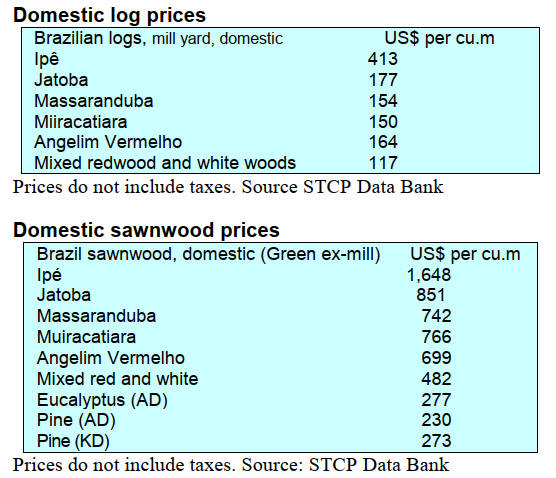
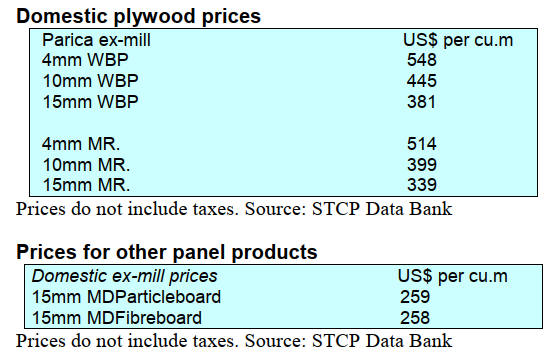
Export prices
Average FOB prices Belém/PA, Paranaguá/PR,
Navegantes/SC and Itajaí/SC Ports.
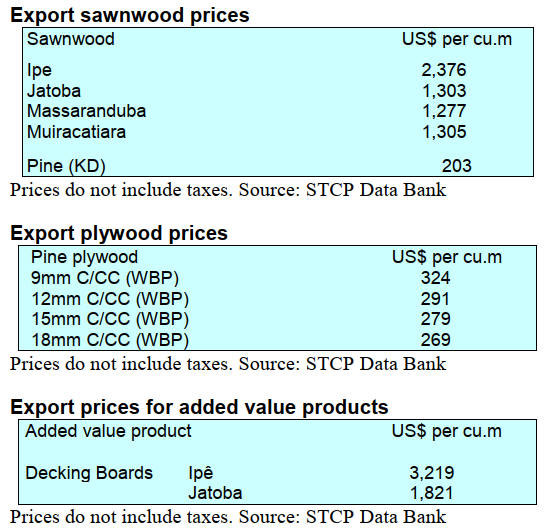
9. PERU
Profiled wood exports
increase
According to information provided by the Services and
Extractive Industries Management of the Exporters
Association (ADEX), shipments of “profiled wood, except
ipé, molded wood, planks and friezes for parquet”,
amounted to US$16.9 million in 2024, increasing by
almost 10% compared to 2023 (US$15.3 million).
European countries imported the highest value with 43%
shipped to France earning US$7.2 million, a year on year
decrease of 4%. According to figures from ADEX's Data
Trade Business Intelligence System, the other 3 main
importers were Denmark (US$2.1 million, up 42% year on
year) and Belgium (US$1.7 million but down year on year
by 23%).
The US imported US$973,000, China with US$911,000,
Mexico US$821,000, Germany US$711,000, New
Zealand US$331,000, South Korea US$318,000 and South
Africa US$241,000.
The information from ADEX highlighted that a large
part
of the shipments were made from Lima Port (44%).
The tariff heading that groups semi-manufactured profiled
wood products was the most important in the wood sector,
with shihuahuaco decking as the outstanding product. The
inclusion of shihuahuaco (Dipteryx spp.) in Appendix II of
CITES impacted the trade at the end of last year
generating an increase in demand in the US and France.
In addition, European countries brought forward their
orders in order to ensure the timely supply of this highly
valued resource.
SERFOR and OSINFOR extend cooperation
In order to strengthen the forestry and wildlife sector of
the country the National Forestry and Wildlife Service
(SERFOR) and the Agency for the Supervision of Forestry
and Wildlife Resources (OSINFOR0 renewed their
Interinstitutional Cooperation Agreement to continue
promoting a legal and competitive forestry and wildlife
sector.
The agreement was renewed and will run to 2030. The
heads of both entities emphasised that, thanks to this
strategic alliance, the expectations of users can be met and
coordinated work can be generated with local and regional
governments, since the aim is to decentralise management
in the sector.
Activities were supported by German Cooperation GIZ
and other international agencies such as JICA, SECO
SUIZA IICA, CIFOR- ICRAF and the Executive Board of
the Ministry of Economy and Finance.
See: https://www.gob.pe/institucion/osinfor/noticias/1103602-
serfor-y-osinfor-suscriben-adenda-de-convenio-para-seguir-
impulsando-el-sector-forestal-y-de-fauna-silvestre-legal
Industrialists to attend Interzum Guangzhou
In March Asia's influential fair Interzum Guangzhou for
the furniture, woodworking machinery and interior
decoration sectors will be held together with the China
International Furniture Fair. A group of Peruvian wood
businessmen will also be present thanks to the Peruvian
consulting firm Tropical Forest Peru, organiser of their
attendance.
Peruvian wooden furniture imports grow
Peruvian wooden furniture imports experienced
remarkable growth in 2024 reaching a total of US$57.62
million, an increase of 48% compared to 2023 (US$ 38.04
million).
Brazil was the main supplier with an increase of 53% in
exports to Peru reaching US$36.65 million. China
followed with an increase of 32% adding another US$8.4
million. In addition, Spain US$2.03 million and Chile
US$1.81 million.
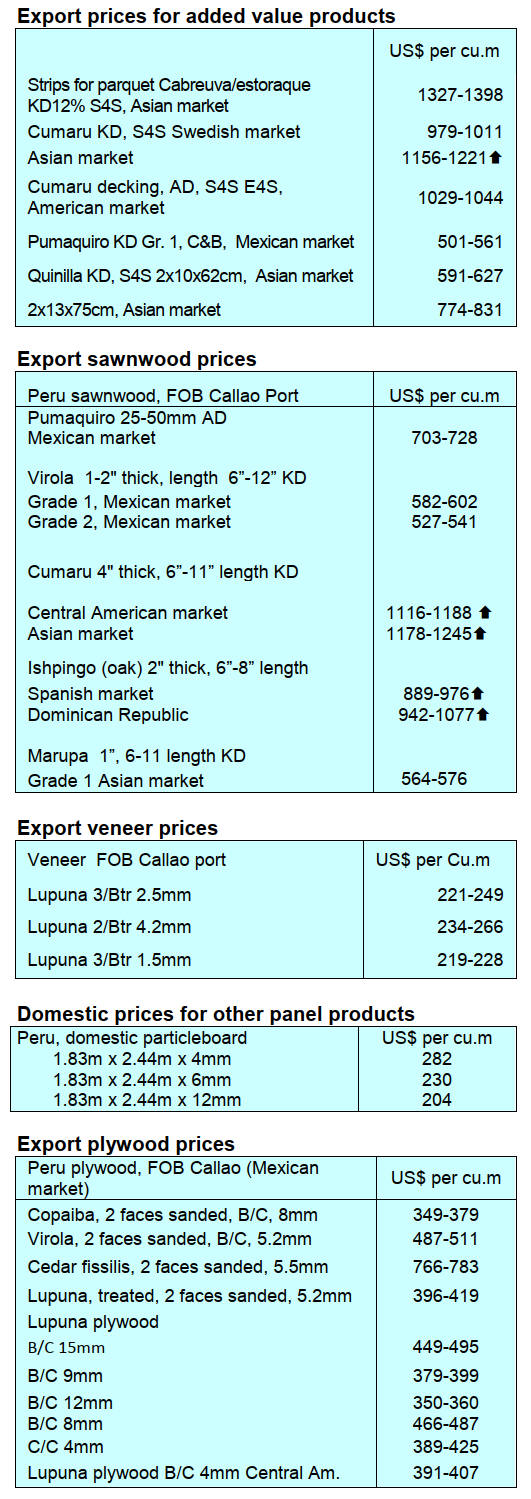

|